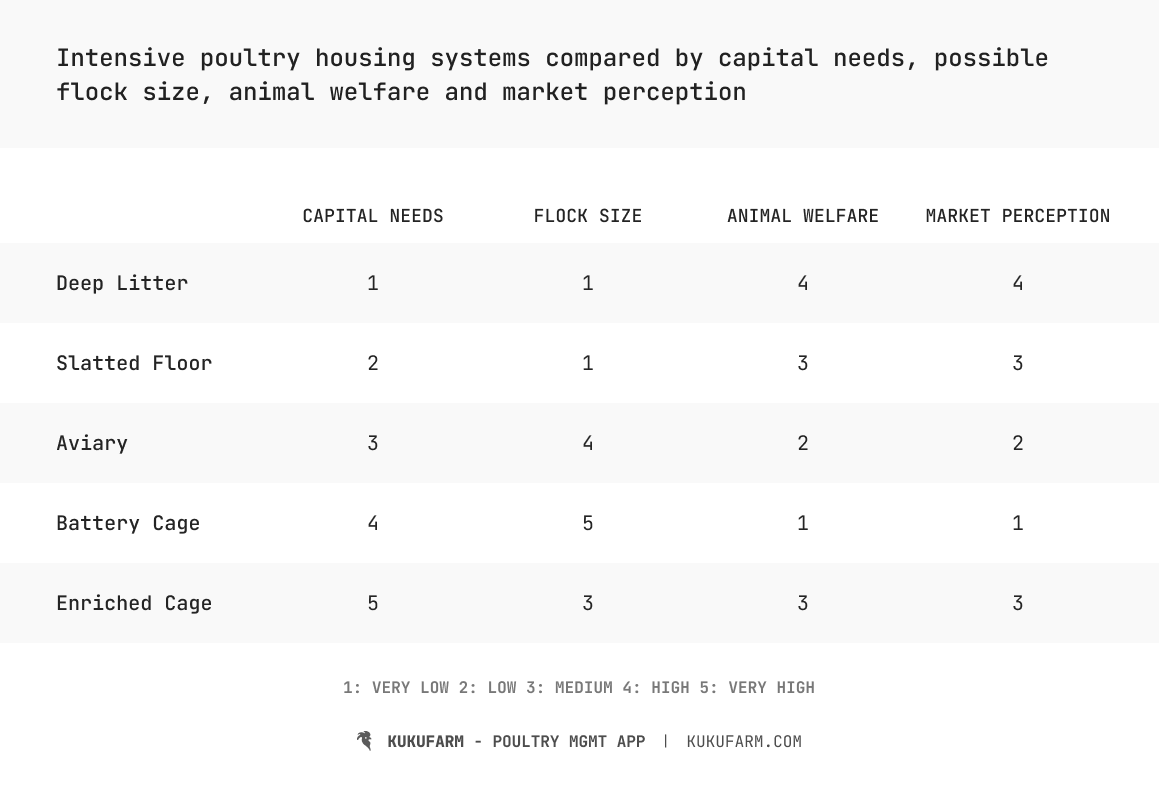Intensive poultry systems have at least 2 fundamental shortcomings. Firstly, they limit natural bird movements and behaviors. Secondly, they do not allow birds to the outdoors.
Nonetheless, intensive poultry systems have been the go to methods for poultry farmers. Usually, this is the case because they enable the application of scientific methods.
In this article, we compare intensive poultry systems to see how they stack up against each other. Notably, this comparison is of our own generalization. Poultry systems can differ from farm to farm. Furthermore, we know that some farmers use a mixture of systems. As a result our comparison cannot be applicable to every case.
Nonetheless, we hope they are informative and give you a brief overview and contrast.
You may also be interested in:
Intensive poultry systems defined
Intensive poultry systems refer to poultry farming and housing systems where flocks spend their lives indoors.

Respectively, there are at least 5 poultry systems that are classified as intensive. These include deep litter, slatted floor, aviary, battery cage and furnished cage systems. To learn more about these systems and how they differ from each other see our previous article: 8 poultry housing systems.
Intensive poultry systems compared
All poultry systems including those classified as extensive have their benefits and shortcomings. Therefore, our intention here is therefore not to disparage any system but merely to show how they compare.

Comparison criteria explained
Intensive poultry systems have certain things in common and in difference. For the purpose of this article, we will use a narrow criteria. This is because we want to keep the comparison short and brief.
We are as a result using a criteria of only four factors, namely capital needs, possible flock size, animal welfare and market perception. We think that these factors are key differentiators of intensive poultry systems. Consequently, this comparison should be more meaningful.
Capital needs
This refers to the amount of funds needed to set up a certain intensive poultry system. Deep litter has the lowest capital needs. On the other hand, we think that furnished cage system is the most capital intensive.
The rest of the intensive poultry systems rank in between deep litter and furnished cage systems.
Flock size
In the same volume, different intensive poultry systems can house varying number of birds. For instance, since in deep litter the birds live on the floor, this system has the lowest possible flock size.
In contrast, aviary and battery cage systems can accommodate large flock sizes. This is because living surfaces are stacked up, thereby increasing number of birds that can be housed in the same floor area.

Slatted floor systems should have more or less the same flock size as deep litter. However, furnished cage system in general accommodate less birds than traditional cage systems since they provide extra spaced cages and furnishings to afford natural behaviors.
Animal welfare
Poultry farming is increasingly moving toward practices that support animal welfare. For instance, the EU has already banned traditional poultry cage systems and is set to ban all cage systems for all animal farming by 2027.

Consequently, animal welfare is yet another key comparison factor for poultry systems. Obviously, battery cage systems are set to rank lowest in this regard. In contrast, deep litter and slatted floor systems rank higher.
Some of the factors contributing to animal welfare in poultry farming. These include the affordance for natural movement and behaviors, perching and nesting, scratching and access to the outdoors. Since all intensive systems do not permit access to the outdoors, they rank lower than extensive systems, in this regard.
Market perception
Market perception or perception of poultry produce by consumer is an important comparison factor. Even though intensive poultry systems have higher market perception, extensive systems do not rank equally. Certain systems have better perception than others.
For instance poultry produce from deep litter systems have better market perception than those from battery cage systems.
Productivity
As unto whether one poultry systems is more productive than another is a very contentious issue. So far, there is data that suggests that from a productivity perspective, intensive poultry systems are not equal.

Mathews and Sumner conducted a comparison study of 3 intensive poultry systems over a 2 flock cycle. Their finding was that an enriched cage system has higher egg production rate than aviary and traditional cage systems.
However, we feel that even though this study was widely published, it cannot necessarily be generalized. In order to conclusively say one system is more productive than another, we would need more data on such comparisons. Nonetheless Mathews and Sumner do give us an idea and something to build upon.
*
Let us know what you think of our comparison in the comments section below.

